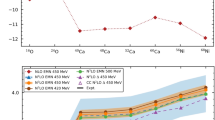Abstract
We summarize recent advances in ab initio nuclear structure theory, aiming to connect few- and many-body systems in a coherent theoretical framework. Starting from chiral effective field theory to construct the nuclear Hamiltonian and the similarity renormalization group to soften it, we address several many-body approaches that have seen major developments over the past few years. We show that the domain of ab initio nuclear structure theory has been pushed well beyond the p-shell and that quantitative predictions connected to QCD via chiral effective field theory are becoming possible all the way from the proton to the neutron drip line up into the medium-mass regime.
Similar content being viewed by others
References
Machleidt R., Entem D.R.: Chiral effective field theory and nuclear forces. Phys. Rep. 503, 1 (2011)
Epelbaum E., Hammer H.-W., Meißner U.-G.: Modern theory of nuclear forces. Rev. Mod. Phys. 81, 1773 (2009)
Entem D.R., Machleidt R.: Accurate charge-dependent nucleon-nucleon potential at fourth order of chiral perturbation theory. Phys. Rev. C 68, 041001(R) (2003)
Navratil P.: Local three-nucleon interaction from chiral effective field theory. Few Body Syst. 41, 117 (2007)
Gazit D., Quaglioni S., Navratil P.: Three-nucleon low-energy constants from the consistency of interactions and currents in chiral effective field theory. Phys. Rev. Lett. 103, 102502 (2009)
Bernard V., Epelbaum E., Krebs H., Meißner U.-G.: Subleading contributions to the chiral three-nucleon force: long-range terms. Phys. Rev. C 77, 064004 (2008)
Bernard V., Epelbaum E., Krebs H., Meissner U.-G.: Subleading contributions to the chiral three-nucleon force II: short-range terms and relativistic corrections. Phys. Rev. C 84, 054001 (2011)
Epelbaum E., Glöckle W., Meißner U.-G.: The two-nucleon system at next-to-next-to-next-to-leading order. Nucl. Phys. A 747, 362 (2005)
Epelbaum E., Nogga A., Glöckle W. et al.: Three-nucleon forces from chiral effective field theory. Phys. Rev. C 66, 064001 (2002)
Ekström A., Baardsen G., Forssén C. et al.: Optimized chiral nucleon-nucleon interaction at next-to-next-to-leading order. Phys. Rev. Lett. 110, 192502 (2013)
Roth, R., Calci, A., Langhammer, J., Binder, S.: Evolved Chiral NN+3N Hamiltonians for Ab Initio Nuclear Structure Calculations. arXiv:1311.3563 (2013)
Roth R., Neff T., Feldmeier H.: Nuclear structure in the framework of the unitary correlation operator method. Prog. Part. Nucl. Phys. 65, 50 (2010)
Bogner S.K., Furnstahl R.J., Schwenk A.: From low-momentum interactions to nuclear structure. Prog. Part. Nucl. Phys. 65, 94 (2010)
Bogner S.K., Furnstahl R.J., Perry R.J.: Similarity renormalization group for nucleon–nucleon interactions. Phys. Rev. C 75, 061001(R) (2007)
Pieper S.C., Varga K., Wiringa R.B.: Quantum Monte Carlo calculations of A = 9,10 nuclei. Phys. Rev. C 66, 044310 (2002)
Pieper S.C., Wiringa R.B., Carlson J.: Quantum Monte Carlo calculations of excited states in A = 6–8 nuclei. Phys. Rev. C 70, 054325 (2004)
Navrátil P., Vary J.P., Barrett B.R.: Properties of 12C in the Ab initio nuclear shell model. Phys. Rev. Lett. 84, 5728 (2000)
Barrett B.R., Navrátil P., Vary J.P.: Ab initio no core shell model. Prog. Part. Nucl. Phys. 69, 131 (2013)
Roth R., Navrátil P.: Ab initio study of 40Ca with an importance-truncated no-core shell model. Phys. Rev. Lett. 99, 092501 (2007)
Roth R.: Importance truncation for large-scale configuration interaction approaches. Phys. Rev. C 79, 064324 (2009)
Roth R., Langhammer J., Calci A. et al.: Similarity-transformed chiral NN+3N interactions for the Ab initio description of 12-C and 16-O. Phys. Rev. Lett. 107, 072501 (2011)
Hagen G., Papenbrock T., Dean D.J., Hjorth-Jensen M.: Ab initio coupled-cluster approach to nuclear structure with modern nucleon–nucleon interactions. Phys. Rev. C 82, 034330 (2010)
Somà à V., Duguet T., Barbieri C.: Ab initio self-consistent Gorkov-Green’s function calculations of semimagic nuclei: formalism at second order with a two-nucleon interaction. Phys. Rev. C 84, 064317 (2011)
Tsukiyama K., Bogner S.K., Schwenk A.: In-medium similarity renormalization group for nuclei. Phys. Rev. Lett. 106, 222502 (2011)
Binder S., Langhammer J., Calci A. et al.: Ab initio calculations of medium-mass nuclei with explicit chiral 3N interactions. Phys. Rev. C 87, 021303 (2013)
Binder S., Piecuch P., Calci A. et al.: Extension of coupled-cluster theory with a noniterative treatment of connected triply excited clusters to three-body Hamiltonians. Phys. Rev. C 88, 054319 (2013)
Roth R., Binder S., Vobig K. et al.: Ab initio calculations of medium-mass nuclei with normal-ordered chiral NN+3N interactions. Phys. Rev. Lett. 109, 052501 (2012)
Hergert H., Bogner S.K., Binder S. et al.: In-medium similarity renormalization group with chiral two- plus three-nucleon interactions. Phys. Rev. C 87, 034307 (2013)
Hergert H., Binder S., Calci A. et al.: Ab initio calculations of even oxygen isotopes with chiral two-plus-three-nucleon interactions. Phys. Rev. Lett. 110, 242501 (2013)
Otsuka T., Suzuki T., Holt J.D. et al.: Three-body forces and the limit of oxygen isotopes. Phys. Rev. Lett. 105, 032501 (2010)
Hagen G., Hjorth-Jensen M., Jansen G.R. et al.: Continuum effects and three-nucleon forces in neutron-rich oxygen isotopes. Phys. Rev. Lett. 108, 242501 (2012)
Hupin G., Langhammer J., Navrátil P. et al.: Ab initio many-body calculations of nucleon-4He scattering with three-nucleon forces. Phys. Rev. C 88, 054622 (2013)
Navrátil P., Kamuntavicius G.P., Barrett B.R.: Few-nucleon systems in a translationally invariant harmonic oscillator basis. Phys. Rev. C 61, 044001 (2000)
Author information
Authors and Affiliations
Corresponding author
Rights and permissions
About this article
Cite this article
Roth, R., Calci, A., Langhammer, J. et al. Ab Initio Nuclear Structure Theory: From Few to Many. Few-Body Syst 55, 659–665 (2014). https://doi.org/10.1007/s00601-014-0860-0
Received:
Accepted:
Published:
Issue Date:
DOI: https://doi.org/10.1007/s00601-014-0860-0




